 W
WSyphilis is a sexually transmitted infection caused by the bacterium Treponema pallidum subspecies pallidum. The signs and symptoms of syphilis vary depending in which of the four stages it presents. The primary stage classically presents with a single chancre though there may be multiple sores. In secondary syphilis, a diffuse rash occurs, which frequently involves the palms of the hands and soles of the feet. There may also be sores in the mouth or vagina. In latent syphilis, which can last for years, there are few or no symptoms. In tertiary syphilis, there are gummas, neurological problems, or heart symptoms. Syphilis has been known as "the great imitator" as it may cause symptoms similar to many other diseases.
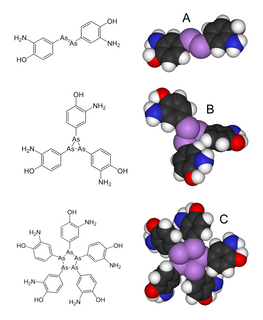 W
WArsphenamine, also known as Salvarsan or compound 606, is a drug that was introduced at the beginning of the 1910s as the first effective treatment for syphilis and African trypanosomiasis. This organoarsenic compound was the first modern antimicrobial agent.
 W
WThis is a list of famous historical figures diagnosed with or strongly suspected as having had syphilis at some time. Many people who acquired syphilis were treated and recovered; some died from it.
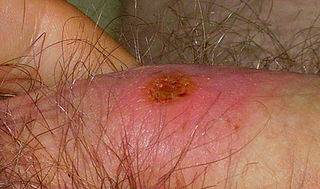 W
WA chancre is a painless genital ulcer most commonly formed during the primary stage of syphilis. This infectious lesion forms approximately 21 days after the initial exposure to Treponema pallidum, the gram-negative spirochaete bacterium yielding syphilis. Chancres transmit the sexually transmissible disease of syphilis through direct physical contact. These ulcers usually form on or around the anus, mouth, penis and vagina. Chancres may diminish between four and eight weeks without the application of medication.
 W
WCongenital syphilis is syphilis present in utero and at birth, and occurs when a child is born to a mother with syphilis. Untreated early syphilis infections results in a high risk of poor pregnancy outcomes, including saddle nose, lower extremity abnormalities, miscarriages, premature births, stillbirths, or death in newborns. Some infants with congenital syphilis have symptoms at birth, but many develop symptoms later. Babies exposed in utero can have deformities, delays in development, or seizures along with many other problems such as rash, fever, an enlarged liver and spleen, anemia, and jaundice. Newborns will typically not develop a primary syphilitic chancre, but may present with signs of secondary syphilis. Often these babies will develop syphilitic rhinitis ("snuffles"), the mucus from which is laden with the T. pallidum bacterium, and therefore highly infectious. Rarely, the symptoms of syphilis go unseen in infants so that they develop the symptoms of latent syphilis, including damage to their bones, teeth, eyes, ears, and brain.
 W
WDr. Ehrlich's Magic Bullet is a 1940 American biographical film directed by William Dieterle and starring Edward G. Robinson, based on the true story of the German doctor and scientist Dr. Paul Ehrlich. The film was released by Warner Bros., with some controversy considering the subject of syphilis in a major studio release. It was nominated for an Oscar for its original screenplay, but lost to The Great McGinty.
 W
WSyphilis is a bacterial infection caused by sexual contact and is believed to have infected 12 million people in 1999 with greater than 90% of cases in the developing world. It affects between 700,000 and 1.6 million pregnancies a year, resulting in spontaneous abortions, stillbirths, and congenital syphilis. In Sub-Saharan Africa syphilis contributes to approximately 20% of perinatal deaths.
 W
WThe syphilis experiments in Guatemala were United States-led human experiments conducted in Guatemala from 1946 to 1948. The experiments were led by physician John Charles Cutler who also participated in the late stages of the Tuskegee syphilis experiment. Doctors infected soldiers, prostitutes, prisoners and mental patients with syphilis and other sexually transmitted diseases, without the informed consent of the subjects. The experiment resulted in at least 83 deaths. Serology studies continued through 1953 involving the same vulnerable populations in addition to children from state-run schools, an orphanage, and rural towns, though the intentional infection of patients ended with the original study. On October 1, 2010, the U.S. President, Secretary of State and Secretary of Health and Human Services formally apologized to Guatemala for the ethical violations that took place. Guatemala condemned the experiment as a crime against humanity, and a lawsuit has since been filed.
 W
WA gumma is a soft, non-cancerous growth resulting from the tertiary stage of syphilis. It is a form of granuloma. Gummas are most commonly found in the liver, but can also be found in brain, heart, skin, bone, testis, and other tissues, leading to a variety of potential problems including neurological disorders or heart valve disease.
 W
WThe first recorded outbreak of syphilis in Europe occurred in 1494/1495 in Naples, Italy, during a French invasion. Because it was spread by returning French troops, the disease was known as "French disease", and it was not until 1530 that the term "syphilis" was first applied by the Italian physician and poet Girolamo Fracastoro. The causative organism, Treponema pallidum, was first identified by Fritz Schaudinn and Erich Hoffmann in 1905. The first effective treatment, Salvarsan, was developed in 1910 by Sahachirō Hata in the laboratory of Paul Ehrlich. It was followed by the introduction of penicillin in 1943.
 W
WHutchinson's teeth is a sign of congenital syphilis. Affected people have teeth that are smaller and more widely spaced than normal and which have notches on their biting surfaces. It is named after Sir Jonathan Hutchinson, an English surgeon and pathologist, who first described it.
 W
WMeningeal syphilis is a chronic form of syphilis infection that affects the central nervous system. Treponema pallidum, a spirochate bacterium, is the main cause of syphilis, which spreads drastically throughout the body and can infect all its systems if not treated appropriately. Treponema pallidum is the main cause of the onset of meningeal syphilis and other treponemal diseases, and it consists of a cytoplasmic and outer membrane that can cause a diverse array of diseases in the central nervous system and brain.
 W
WNeurosyphilis refers to infection of the central nervous system in a patient with syphilis. In the era of modern antibiotics the majority of neurosyphilis cases have been reported in HIV-infected patients. Meningitis is the most common neurological presentation in early syphilis. Tertiary syphilis symptoms are exclusively neurosyphilis, though neurosyphilis may occur at any stage of infection.
 W
WBejel, or endemic syphilis, is a chronic skin and tissue disease caused by infection by the endemicum subspecies of the spirochete Treponema pallidum. Bejel is one of the "endemic trepanematoses", a group that also includes yaws and pinta. Typically, endemic trepanematoses begin with localized lesions on the skin or mucous membranes. Pinta is limited to affecting the skin, whereas bejel and yaws are considered to be invasive because they can also cause disease in bone and other internal tissues.
 W
WSaddle nose is a condition associated with nasal trauma, congenital syphilis, relapsing polychondritis, granulomatosis with polyangiitis, cocaine abuse, and leprosy, among other conditions. The most common cause is nasal trauma. It is characterized by a loss of height of the nose, because of the collapse of the bridge. The depressed nasal dorsum may involve bony, cartilaginous or both bony and cartilaginous components of the nasal dorsum.
 W
WThe hospital of San Giacomo in Augusta, also known as San Giacomo degli Incurabili was a historic hospital located in Rome.
 W
WThe Soviet–German Syphilis Expedition was a joint Soviet and German expedition that took place in 1928. It comprised eight medical researchers from each country and its purpose was to investigate endemic syphilis in the Kul’skoe region of the Buryat-Mongolian Autonomous Republic in Siberia and to determine the efficacy of the anti-syphilis drug Salvarsan. The expedition concluded, contrary to expectations, that although affected by poor sanitation and lifestyle, the spread of syphilis in the area was caused primarily by sexual activity.
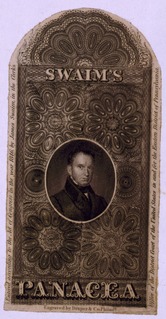 W
WSwaim's Panacea was an American patent medicine sold by William Swaim (1781–1846) of Philadelphia, starting in approximately 1820, with formulations still being sold into at least the 1920s. It was advertised to cure various diseases including scrofula, mercurial disease, deep-seated syphilis, rheumatism, sores, swellings, etc.
 W
WThe Treponema pallidum particle agglutination assay is an indirect agglutination assay used for detection and titration of antibodies against the causative agent of syphilis, Treponema pallidum subspecies pallidum. It also detects other treponematoses.
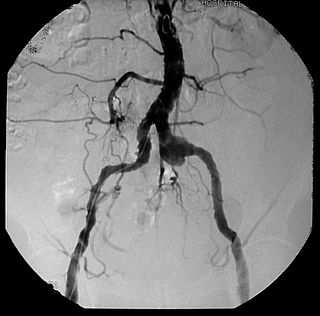 W
WSyphilitic aortitis is inflammation of the aorta associated with the tertiary stage of syphilis infection. SA begins as inflammation of the outermost layer of the blood vessel, including the blood vessels that supply the aorta itself with blood, the vasa vasorum. As SA worsens, the vasa vasorum undergo hyperplastic thickening of their walls thereby restricting blood flow and causing ischemia of the outer two-thirds of the aortic wall. Starved for oxygen and nutrients, elastic fibers become patchy and smooth muscle cells die. If the disease progresses, syphilitic aortitis leads to an aortic aneurysm. Overall, tertiary syphilis is a rare cause of aortic aneurysms. Syphilitic aortitis has become rare in the developed world with the advent of penicillin treatments after World War II.
 W
WTabes dorsalis is a late consequence of neurosyphilis, characterized by the slow degeneration of the neural tracts primarily in the dorsal root ganglia of the spinal cord. These patients have lancinating nerve root pain which is aggravated by coughing, and features of sensory ataxia with ocular involvement.
 W
WTreponema pallidum is a spirochaete bacterium with various subspecies that cause the diseases syphilis, bejel, and yaws. It is transmitted only amongst humans. It is a helically coiled microorganism usually 6–15 μm long and 0.1–0.2 μm wide. T. pallidum's lack of metabolic pathways results in minimal metabolic activity. The treponemes have a cytoplasmic and an outer membrane. Using light microscopy, treponemes are visible only by using dark field illumination. Treponema pallidum consists of 3 subspecies, T. p. pallidum, T. p. endemicum, andT. p. pertenue, each of these subspecies has a distinct disease associated with them.
 W
WThe Tuskegee Syphilis Study, also known as the Tuskegee Syphilis Experiment, Tuskegee Study of Untreated Syphilis in the African American Male, U.S. Public Health Service Syphilis Study at Tuskegee, or Tuskeegee Experiment, was a clinical study conducted between 1932 and 1972 by the United States Public Health Service (PHS) and the Centers for Disease Control and Prevention (CDC). The purpose of this study was to observe the natural history of untreated syphilis; the African-American men in the study were told they were receiving free health care from the Federal government of the United States.
 W
WThe Venereal Disease Research Laboratory test (VDRL) is a blood test for syphilis and related non-venereal treponematoses that was developed by the eponymous lab. The VDRL test is used to screen for syphilis, whereas other, more specific tests are used to diagnose the disease.
 W
WThe Wassermann test or Wassermann reaction (WR) is an antibody test for syphilis, named after the bacteriologist August Paul von Wassermann, based on complement fixation. It was the first blood test for syphilis and the first in the nontreponemal test (NTT) category. Newer NTTs, such as the RPR and VDRL tests, have mostly replaced it.
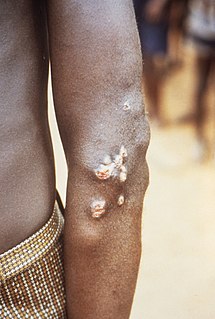 W
WYaws is a tropical infection of the skin, bones and joints caused by the spirochete bacterium Treponema pallidum pertenue. The disease begins with a round, hard swelling of the skin, 2 to 5 centimeters in diameter. The center may break open and form an ulcer. This initial skin lesion typically heals after three to six months. After weeks to years, joints and bones may become painful, fatigue may develop, and new skin lesions may appear. The skin of the palms of the hands and the soles of the feet may become thick and break open. The bones may become misshapen. After five years or more large areas of skin may die, leaving a scar.